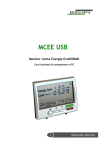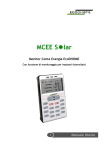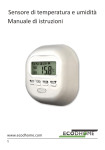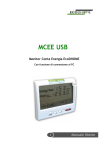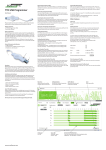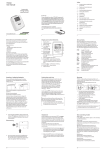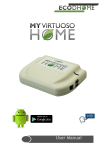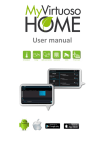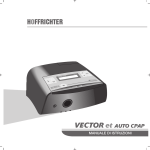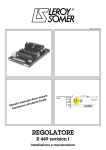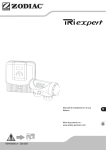Download Manuale di istruzioni Sensore apertura porte
Transcript
Sensore apertura porte/finestre Manuale di istruzioni www.ecodhome.com 1 Sommario 3 – Introduzione 4 – Descrizione e specifiche prodotto 4 – Installazione 5 – Montaggio 7 – Funzionamento 8 – Risoluzione problemi 8 – Smaltimento 9 – Garanzia 2 Introduzione SmartDHOME vi ringrazia per aver scelto questo sensore apertura porte/finestre per l’automazione e la sicurezza degli impianti. Il presente modulo è un dispositivo certificato Z-Wave, compatibile con qualsiasi rete abilitata Z-Wave. Tutti i dispositivi Z-Wave alimentati dalla rete elettrica svolgono anche la funzione di ripetizione di segnale per i dispositivi alimentati a batterie, aiutando ad eliminare possibili zone d’ombra del segnale. L’inclusione del sensore porta/finestra nel sistema wireless consente accensione remota di moduli collegati e la loro illuminazione collegata quando il sensore porta/finestra viene attivato. 3 Descrizione e specifiche prodotto Il presente dispositivo è stato studiato per un utilizzo interno. Specifiche Protocollo: Z-Wave. Frequenza di trasmissione: 868.42 MHz. Portata del segnale: 30 m in campo aperto. Batterie: 1.5V AAA x 3. Dimensione: 120 (A) * 27 (L) * 20 (P) mm. Contenuto confezione 1 Sensore apertura porta/finestra. 1 Manuale di istruzioni. Installazione 1. 4 Sulla parte posteriore del dispositivo si trova il tamper con il quale è possibile effettuare l’inclusione, l’esclusione, il reset o l’associazione. Subito dopo l’inserimento delle batterie il LED si accenderà e si spegnerà ripetutamente ad intervalli di 2 secondi. Questi implica che il dispositivo non è stato associato a nessun gateway Z-wave. Il sensore porta/finestra rimarrà “sveglio” per 10 minuti per dare il tempo alla configurazione. 2. 3. Per l’inclusione nel gateway: posizionare l’interfaccia in modalità di inclusione/esclusione premere il tamper per 3 volte ed entro 1.5 sec. il dispositivo entrerà in modalità inclusione/esclusione. Il LED si accenderà ogni volta che si premerà il tamper. Per il reset, premere il tamper on/ff per 3 volte entro 1.5 sec. , quindi entro 1 sec. tenere premuto il tamper fino a quando il LED si spegne. A questo punto il dispositivo sarà resettato e ripristinate le impostazioni di fabbrica. Montaggio 1. Svitare la vite dal bordo inferiore del sensore. 2. Inserire 3 batterie 1.5V AAA in dotazione al vano batterie. 5 Nota: L’adozione di batterie alcaline è altamente raccomandato, in quanto sarebbe durato per un periodo più lungo. 3. Senza premere il tamper del sensore, staccando il magnete dal sensore il LED del sensore si accenderà. 4. Utilizzando il coperchio posteriore come modello, contrassegnare le posizioni dei fori di fissaggio sulla parte fissa della porta o finestra. 5. Montare il sensore con le viti di fissaggio in dotazione. Non stringere eccessivamente le viti di fissaggio in quanto ciò potrebbe distorcere o danneggiare l’involucro. 6. Montare il magnete sulla parte mobile della porta o della finestra di fronte al sensore con il nastro adesivo o viti di fissaggio 19 mm. Assicurarsi che il divario parallelo fra il magnete e sensore è inferiore a 10 millimetri e che la linea corrispondente sul magnete sia allineata con la linea sul sensore. 7. Se devono essere protette diverse finestre, adottare il filo in base alle specifiche come indicato di seguito. Questo dovrebbe essere collegato alla morsettiera fornita nel vano batteria in collegamento in 6 serie. Si consiglia di usare un cavo a due conduttori AWG di lunghezza massima 4m. Nota: Dopo aver rimosso le batterie, attendere 5 secondi per rimontare le batterie. Connessione interna Connessione cablata esterna Funzionamento 1. Il dispositivo rimarrà “sveglio” per dieci minuti quando l’alimentazione viene fornita per dare il tempo per la configurazione. 2. Successivamente il dispostivo rimane in modalità sleep time e può essere svegliato premendo il tamper fino a quando il LED si accende una volta. Il sensore entrerà nuovamente in sleep time dopo 10 secondi. Se si desidera tenere il sensore sveglio per 10 minuti allora premere il tamper tre volte entro 1.5 secondi. 3. Non premendo il tamper, il sensore entrerà nella modalità di test che permetterà ad utente di testarlo. Staccando il magnete dal sensore il LED si 7 accendrà. 4. Quando il tamper è premuto, il sensore entra nella modalità normale e il LED rimane spento per risparmiare le batterie. Risoluzione problemi Problema Causa Soluzione Non è possibile effettuare l’inclusione e l’associazione. 1. Il dispositivo è associato ad un altro Controller Z-Wave. 2. Non sono inserite le batterie oppure sono scariche. 1. Escludere il dispositivo e riprovare l’inclusione o l’associazione. 2. Controllare se le batterie sono inserite oppure sostituirle. LED non si illumina e non funziona. 1. Non sono inserite le batterie oppure sono scariche. 2. Dispositivo guasto. 1. Controllare se le batterie sono inserite oppure sostituirle. 2. Inviare il dispositivo al fornitore per la riparazione e non aprirlo. Smaltimento Non smaltire apparecchi elettrici nei rifiuti urbani indifferenziati, utilizzare servizi di raccolta differenziata. Contattare il comune locale per informazioni riguar8 danti i sistemi di raccolta disponibili. Se gli apparecchi elettrici vengono smaltiti in discariche o nei posti non appropriati, le sostanze pericolose possono fuoriuscire nelle acque sotterranee ed entrare nella catena alimentare, danneggiando la salute e il benessere. Quando si sostituisce vecchi elettrodomestici con quelli nuovi, il rivenditore è legalmente obbligato a ritirare il vecchio apparecchio per lo smaltimento gratuitamente. Garanzia Visita il link: http://www.ecodhome.com/acquista/garanzia-e-riparazioni.html SmartDHOME Srl www.ecodhome.com [email protected] Rev. 03/2014 9 P/N 01335-1100-00 Door/window opening sensor Installation Manual www.ecodhome.com 10 Summary 12– Introduction 13– Product description and specification 13– Installation 14– Mounting 16– Operation 17– Troubleshooting 17– Warning 18– Limited warranty 11 Introduction Thanks for choosing the SmartDhome door/window opening sensor for pairing with the home automation gateway. This module is a Z-Wave enabled device and is fully compatible with any Z-Wave enabled network. Every mains powered Z-Wave enabled device acts as a signal repeater and multiple devices result in more possible transmission routes, which helps eliminate “RF dead-spots”. Inclusion of this Door/Window Detector on other manufacturer’s Wireless Controller, allows remote control of connected modules and their connected lighting, when the Detector is triggered. 12 Product description and specification For indoor use only. Specification Protocol: Z-Wave. Frequency range: 868.42 MHz. Operating range: 30 m uninterrupted. Battery: 1.5V AAA size x 3 Dimensions: 120 (H) * 27 (W) * 20 (D) mm. Package content 1 Door/window opening sensor. 1 Installation manual. Installation 1. 13 On the rear casing, there is a tamper switch which is used to carry out the inclusion, exclusion or association. When power is first applied, its LED flashes on and off alternately and repeatedly at 2-second intervals. This means that it has not been assigned a node ID and cannot work with Z-Wave enabled devices. The Detector will stay “awake” for 10 minutes when power is first applied to allow time for configuration. 1. 2. To put a Z-Wave wireless controller into inclusion/ exclusion mode, press tamper switch three times within 1.5 seconds. LED lights up once whenever tamper switch is pressed. To reset the module press tamper three times whithin 1.5 seconds, then within a further 1 second, press and hold the tamper switch until LED is off. The device is excluded and all of preset values will be reset to factory default. LED stays on until reset function has been completed. Mounting 1. Undo and remove the fixing screw from the bottom edge of the Detector. Remove the rear cover. 2. Fit 3 1.5V AAA batteries into to the battery compartment. 14 Note: using an alkaline battery is highly recommended, as they last longer. 3. By releasing the tamper switch on the Detector, and detaching or close the magnet from the Detector, the LED on the Detector will illuminate. 4. Using the rear cover as a template, mark the positions of fixing holes on the fixed part of the frame , along the opening edge opposite the hinges, using screws provided. 5. Refit the Detector to the rear cover and secure with the fixing screw supplied. Do not over tighten the fixing screws as this may distort or damage the casing. 6. Fit the Magnet to the moving part of the door/ window opposite the Detector using the adhesive tape or 19mm fixing screws. Ensure that the parallel gap between the Magnet and Detector is less than 10mm and that the matching line on the Magnet is pointing towards and aligned with the line on the Detector. 7. If several windows need to be protected, set the wire according to the drawing shown below. This should be wired to the terminal block provided in the battery compartment in series connection. 15 The wired contact should be connected using two core (AWG) wire of maximum length 4m. A cable entry cut-out is present and adjacent to the terminal block. Choose either the internal or external wired connection, connection (both cannot be used at the same time). Note: After removing batteries, wait for 5 seconds to refit. Internal connection External wired connection Operation 1. The unit will stay “awake” for ten minutes when power is first supplied to allow time for configuration. 2. Once the unit is in sleep mode, it can be woken up by pressing the tamper switch continuously until the LED lights up once. The unit will enter sleep status again after 10 seconds. If longer is desired, press tamper switch three times within 1.5 seconds, prolonging its awake period to 10 minutes. 3. With the tamper switch not being pressed, the unit enters test mode, which allows the user to test 16 device. Detach the magnet from the Detector, the red indicator LED on the Detector will illuminate. 4. When the tamper switch is pressed, the unit enters normal mode and the red indicator LED on the Detector will not illuminate, to conserve battery life (unless the battery is low). Troubleshooting Symptom Cause of Failure Recommendation Cannot carry out inclusion and association Included a node ID allocated by other Z-Wave Controller. Exclude a node ID then carry out inclusion and association with new Controller. LED not illuminating and not working 1. No batteries or run out of battery power. 2. Device broken. 1. Check if batteries are fitted or replace with a new battery. 2. Do not open up the unit, contact your supplier. Warning Do not dispose of electrical appliances along with general waste, use separate collection facilities. Contact your local government for information regard17 ing the collection systems available. If electrical appliances are disposed of in landfills or dumps, hazardous substances can leak into the groundwater damaging the environment and human health. When replacing old appliances with new ones, the retailer is legally obligated to take back your old appliance for disposal free of charge. Limited warranty Visit our website: http://www.ecodhome.com/acquista/garanzia-e-riparazioni.html SmartDHOME Srl www.ecodhome.com [email protected] For United Kingdom and Ireland only, refer to: www.ecodhome.co.uk [email protected] Rev. 03/2014 18 P/N 01335-1100-00


















